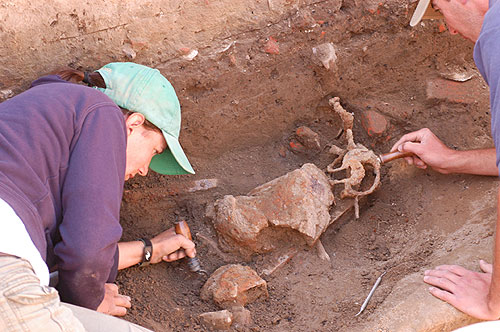Post by LongBlade on Jun 30, 2007 21:11:50 GMT -5
Sword, armor found buried inside remains of James Fort
By DIANE TENNANT
The Virginian-Pilot
South Hampton Roads, Southeast VA & Northeast NC
May 9, 2007
content.hamptonroads.com/story.cfm?story=124313&ran=209568&tref=po
JAMESTOWN - A cache of armor from the early 1600s has been discovered by archaeologists excavating a trash pit inside the remains of James Fort.
Queen Elizabeth II viewed the objects during her visit Friday, observing a broadsword with a basket hilt, an iron pole, the hilt from a rapier and armor pieces that would have protected the thigh.

Archaeologists Mary Anna Richardson, left, and Luke Pecoraro carefully begin excavating a potential cache of arms and armor that so far includes a broad sword with a basket hilt and blade, armor that protects the thigh and a rapier hilt, discovered recently at Historic Jamestowne. PHOTO BY MICHAEL LAVIN / APVA PRESERVATION VIRGINIA
"It may be like the tip of an iceberg," said William Kelso, director of archaeology for APVA Preservation Virginia, in a news release. "We'll see as we uncover more of it in the next few days."
The armor was partly uncovered last week, about 3 feet below what would have been ground level in the early 1600s.
The pit itself is 19 feet square. Because the layers slump toward the center, archaeologists think it might have been a well that went bad, and was then used for trash.
Glass trade beads, baubles, chess pieces, iron objects and pottery shards have also been found in the pit. Indian artifacts found there include a grinding stone, a bone needle and shell beads.
Animal remains include oysters, sturgeon, crab claws, fish, bird, turtle, deer and goat.
Kelso speculated that it could be the first well dug by colonist John Smith in 1608-09. Archaeologists can date it by the artifacts, which include a coin dated 1613 found near the top, and by the fact that the pit is under the foundation of a building constructed in 1617.
Furthermore, historical accounts mention that military equipment was buried in the fort in June 1610, when the colonists decided to abandon Jamestown after the "Starving Time" winter.
The day after they left, they were forced to return by Lord De La Warre, whose supply fleet coming up the James River met the dispirited colonists coming down.
Archaeologists also plan to work on a site this summer that they hope contains remnants of the first church built for the colony.
By DIANE TENNANT
The Virginian-Pilot
South Hampton Roads, Southeast VA & Northeast NC
May 9, 2007
content.hamptonroads.com/story.cfm?story=124313&ran=209568&tref=po
JAMESTOWN - A cache of armor from the early 1600s has been discovered by archaeologists excavating a trash pit inside the remains of James Fort.
Queen Elizabeth II viewed the objects during her visit Friday, observing a broadsword with a basket hilt, an iron pole, the hilt from a rapier and armor pieces that would have protected the thigh.

Archaeologists Mary Anna Richardson, left, and Luke Pecoraro carefully begin excavating a potential cache of arms and armor that so far includes a broad sword with a basket hilt and blade, armor that protects the thigh and a rapier hilt, discovered recently at Historic Jamestowne. PHOTO BY MICHAEL LAVIN / APVA PRESERVATION VIRGINIA
"It may be like the tip of an iceberg," said William Kelso, director of archaeology for APVA Preservation Virginia, in a news release. "We'll see as we uncover more of it in the next few days."
The armor was partly uncovered last week, about 3 feet below what would have been ground level in the early 1600s.
The pit itself is 19 feet square. Because the layers slump toward the center, archaeologists think it might have been a well that went bad, and was then used for trash.
Glass trade beads, baubles, chess pieces, iron objects and pottery shards have also been found in the pit. Indian artifacts found there include a grinding stone, a bone needle and shell beads.
Animal remains include oysters, sturgeon, crab claws, fish, bird, turtle, deer and goat.
Kelso speculated that it could be the first well dug by colonist John Smith in 1608-09. Archaeologists can date it by the artifacts, which include a coin dated 1613 found near the top, and by the fact that the pit is under the foundation of a building constructed in 1617.
Furthermore, historical accounts mention that military equipment was buried in the fort in June 1610, when the colonists decided to abandon Jamestown after the "Starving Time" winter.
The day after they left, they were forced to return by Lord De La Warre, whose supply fleet coming up the James River met the dispirited colonists coming down.
Archaeologists also plan to work on a site this summer that they hope contains remnants of the first church built for the colony.

